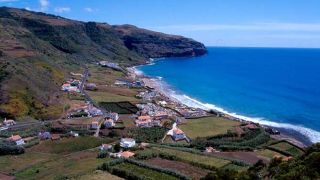Santa Maria, the sunshine island

The island of Santa Maria is in the Eastern Group of the Azores archipelago, along with São Miguel, 81km away. The green fields, traditional culture, the chimneys of the whitewashed houses, the dark ochre of the earth, the golden beaches and the turquoise waters make Santa Maria different from the archipelago’s other islands.
Because it is the most southerly and easterly island in the Azores, Santa Maria’s climate is warmer and drier, which contributes to greater aridity on the land and dry vegetation with a yellowish tint, and for this reason it is also known as the Sunshine Island.
The island has two areas with distinctive reliefs and features: one area to the west is flatter and low-lying where the airport can be found, and the houses of Vila do Porto, the largest town on the island, and the parishes of São Pedro and Almagreira; and another more rugged area in the east of the island, with lush vegetation, which includes the Pico Alto mountain, the highest point on the island at 590 metres above sea level, from which you have a wonderful panoramic view. The parishes of Santa Bárbara and Espírito Santo are located in this region.
Santa Maria was the first island to be discovered by the Portuguese explorers, the first to be settled, and was also the first island in the Azores to be formed, so its diverse geological past is etched into its volcanic and sedimentary rocks. This can be seen in Pedreira do Campo, where a basalt flow more than 100 metres high houses within it numerous fossils of marine organisms, proving that this island was submerged until a few thousand years ago. This geological wealth can also be admired in the Dalberto Pombo Environmental Interpretation Centre, right in the historic centre of Vila do Porto.
The so-called "barreiros" of Santa Maria are also worth seeing, terrains of reddish to bright orange hues, with an arid appearance and a clayey nature, the most famous being the Barreiro da Faneca, known as the "red desert." It is considered an area of unique Protected Landscape in the Azores, which also includes the Raposo, Tagarete and Cré Bays.
The volcanic shapes on the island are particularly impressive at Ribeira de Maloás, where the river valley features a waterfall of about 20m, resulting from the contact of a lava flow with the sea.
Santa Maria is also known for its jagged coastline, high rocky headlands and bays of calm, crystal clear waters, which offer a standing invitation to explore. This is certainly the case of Cré, Raposa and Tagarete Bays, but also many others.
In São Lourenço, the natural beauty of the bay shaped like an amphitheatre is complemented by the vineyards on the hillside terraces above the white houses by the sea, and the cove which has a wonderful beach of white sand and rock pools. At the far end of the beach lies the Islet of Romeiro.
Praia Formosa is one of the most popular beaches on the island, either for its extensive stretch of fine sand and clear water, or because it is one of the best spots for surfing.
The houses of Vila do Porto retain some traces of the early settlement, some bearing ogival doors and windows in the Manueline style. The Parish Church of Nossa Senhora da Assunção, the town’s patron saint, is one of the oldest churches in the Azores, although it has undergone various alterations over time. In the São Brás Fort, guns pointing out to sea recall the days of pirate attacks. In Espírito Santo, it’s worth taking a look at the Baroque facade of the Church of Nossa Senhora da Purificação, as well as paying a visit to the Santa Maria Museum, housed in a typical house, with its two tubular chimneys and pot-bellied oven, architectural elements characteristic of rural Santa Maria.
In Anjos, besides its beautiful bay, there’s a statue of Christopher Columbus and the Chapel of Nossa Senhora dos Anjos where, according to legend, the explorer attended a Mass on his return from America.
The chromatic colour schemes are also notable in the traditional houses of Santa Maria, mostly inspired by the traditional architecture of the Alentejo and Algarve, where the first settlers of this island came from. These homes have a rectangular shape from which emerges a cylindrical chimney resting on an unfinished pyramid, and each of the island’s five parishes has adopted a different colour to contrast with the white masonry.






















 Explore
Explore 
 Remember and Share
Remember and Share 


